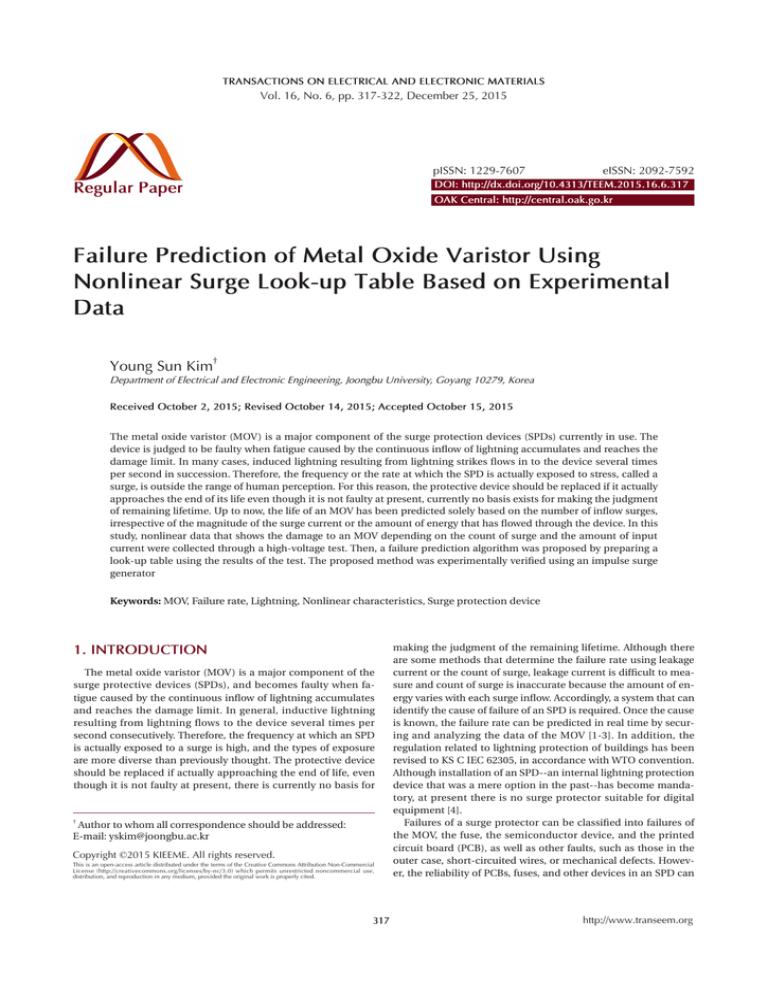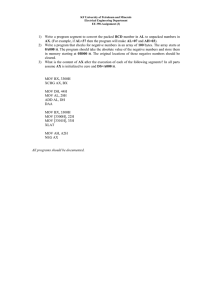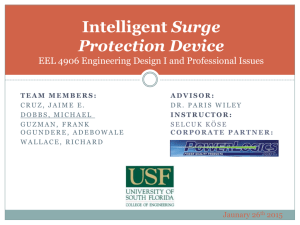
TRANSACTIONS ON ELECTRICAL AND ELECTRONIC MATERIALS
Vol. 16, No. 6, pp. 317-322, December 25, 2015
pISSN: 1229-7607
Regular Paper
eISSN: 2092-7592
DOI: http://dx.doi.org/10.4313/TEEM.2015.16.6.317
OAK Central: http://central.oak.go.kr
Failure Prediction of Metal Oxide Varistor Using
Nonlinear Surge Look-up Table Based on Experimental
Data
†
Young Sun Kim
Department of Electrical and Electronic Engineering, Joongbu University, Goyang 10279, Korea
Received October 2, 2015; Revised October 14, 2015; Accepted October 15, 2015
The metal oxide varistor (MOV) is a major component of the surge protection devices (SPDs) currently in use. The
device is judged to be faulty when fatigue caused by the continuous inflow of lightning accumulates and reaches the
damage limit. In many cases, induced lightning resulting from lightning strikes flows in to the device several times
per second in succession. Therefore, the frequency or the rate at which the SPD is actually exposed to stress, called a
surge, is outside the range of human perception. For this reason, the protective device should be replaced if it actually
approaches the end of its life even though it is not faulty at present, currently no basis exists for making the judgment
of remaining lifetime. Up to now, the life of an MOV has been predicted solely based on the number of inflow surges,
irrespective of the magnitude of the surge current or the amount of energy that has flowed through the device. In this
study, nonlinear data that shows the damage to an MOV depending on the count of surge and the amount of input
current were collected through a high-voltage test. Then, a failure prediction algorithm was proposed by preparing a
look-up table using the results of the test. The proposed method was experimentally verified using an impulse surge
generator
Keywords: MOV, Failure rate, Lightning, Nonlinear characteristics, Surge protection device
1. INTRODUCTION
The metal oxide varistor (MOV) is a major component of the
surge protective devices (SPDs), and becomes faulty when fatigue caused by the continuous inflow of lightning accumulates
and reaches the damage limit. In general, inductive lightning
resulting from lightning flows to the device several times per
second consecutively. Therefore, the frequency at which an SPD
is actually exposed to a surge is high, and the types of exposure
are more diverse than previously thought. The protective device
should be replaced if actually approaching the end of life, even
though it is not faulty at present, there is currently no basis for
†
Author to whom all correspondence should be addressed:
E-mail: yskim@joongbu.ac.kr
Copyright ©2015 KIEEME. All rights reserved.
This is an open-access article distributed under the terms of the Creative Commons Attribution Non-Commercial
License (http://creativecommons.org/licenses/by-nc/3.0) which permits unrestricted noncommercial use,
distribution, and reproduction in any medium, provided the original work is properly cited.
Copyright
2011 KIEEME. All rights reserved.
317
making the judgment of the remaining lifetime. Although there
are some methods that determine the failure rate using leakage
current or the count of surge, leakage current is difficult to measure and count of surge is inaccurate because the amount of energy varies with each surge inflow. Accordingly, a system that can
identify the cause of failure of an SPD is required. Once the cause
is known, the failure rate can be predicted in real time by securing and analyzing the data of the MOV [1-3]. In addition, the
regulation related to lightning protection of buildings has been
revised to KS C IEC 62305, in accordance with WTO convention.
Although installation of an SPD--an internal lightning protection
device that was a mere option in the past--has become mandatory, at present there is no surge protector suitable for digital
equipment [4].
Failures of a surge protector can be classified into failures of
the MOV, the fuse, the semiconductor device, and the printed
circuit board (PCB), as well as other faults, such as those in the
outer case, short-circuited wires, or mechanical defects. However, the reliability of PCBs, fuses, and other devices in an SPD can
http://www.transeem.org
Trans. Electr. Electron. Mater. 16(6) 317 (2015): Y. S. Kim
318
be secured through sufficient quality control protocols before
they are shipped by the manufacturer. Accordingly, the problems
caused by changes in these devices during the use of the product can be identified visually or by instrumentation; however, it
is impossible to identify the condition of an MOV visually or by
measurement. Therefore, the failure of an SPD can be presumed
to be a failure of the MOV, and damage to the MOV can be selected as the major cause for failure of the SPD [5-8].
A nonlinear look-up table was prepared by experimentally
verifying the relationship between the amount of inflow energy
and the damage limit of the surge. Based on this relationship, an
algorithm to predict the failure rate of MOVs was established. A
life test of an MOV, a major cause for the failure of a surge protector, was repeatedly carried out using an 8/20 [μs] surge wave.
The nonlinear relationship between the size and the count of the
surge was examined. The amount of energy that flows into the
MOV is defined. The amount of energy that flows into the MOV
was defined to determine the failure rate and verified.
2. FAILURE RATE PREDICTION ALGORITHM
2.1 Characteristics and failure types of MOVs
In an MOV, there is an electrode at each end and inside each
end is ZnO particles, as shown in Fig. 1. The average number of
ZnO particles between the two electrodes is an important factor
that determines the voltage of the MOV. The MOV is connected
in parallel to the equipment or circuit it is meant to protect,
preventing the voltage from increasing further by forming a lowresistance circuit when excessive voltage occurs. If the thickness
of the MOV is increased twofold, twice as many micro-MOVs are
connected in series and increasing the protection level by twofold. In addition, if the area of the product is increased twofold,
the current path increases twofold and doubles the tolerated
value of the surge current because they are connected in parallel.
In existing surge protectors, it is impossible to determine the
damage and failure due to nonlinear characteristics. For example, the insulation property changes very slowly in the MOV, and
degenerates rapidly at the moment the surge limit of the device
is reached after exposure to a surge.
Fig. 1. Interior structure of metal oxide varistor; (a) Zink oxide which
a metallic oxidant has been added and (b) grain structure of zinc oxide.
An MOV, made of a mixture of 90% zinc oxide and 10% additives, has excellent insulation performance and very high resistance below the critical voltage, and becomes conductive above
the critical voltage as the resistance rapidly drops. MOV is the
most stable device for suppressing surge because of its superior
clamping property and is used in most surge protectors. Damage
to an MOV can be classified as thermal runaway, puncture, crack,
or epoxy breakaway, based on its appearance, as shown in Fig. 2.
2.2 Calculation of lightning stroke current and
energy inflow
An experiment was repeated many times to measure the count
of the surge before the damage limit was reached and depending
on the amount of energy flowing into the MOV. A 100% failure
rate was set by measuring the energy and the count immediately
before the MOV was damaged. In addition, from the results of
the experiments, the failure rate was defined for each count,
depending on the amount of energy at which time the nonlinear
look-up table obtained through the experiment was used. If the
proposed method is applied to a product, the failure rate and
the remaining life can be predicted even when a random-size
surge flows into the surge protector a random number of times.
This can reduce the number of malfunctions and increase the
reliability of the surge protector by allowing the user know the
replacement time. In the future, studies need to be performed to
define the failure rate, even during a continuous surge flows and
for random surge waveforms by reflecting the temperature of the
device and the leakage current. In KS C IEC 61643, the lightning
stroke current appears as the standard waveform shown in Fig. 3,
and is defined as shown in (1). Moreover, if this current flows into
the MOV, the energy inflow is as shown in (2). An 8/20 waveform
is a current waveform in which it takes 8 μs for the current to rise
from 10% on the impulse rising curve to 90% of the maximum
current value, and 20 μs for it to reach 50% of the maximum
value on the falling curve, and a 10/350 waveform has the same
meaning.
Fig. 3. Standard lightning currents (8/20 and 10/350 waves).
t
(a)
(b)
(c)
(d)
(− )
ip
(t / τ 1 )10
i=
×
× e τ2
10
K 1 + (t / τ 1 )
Here,
Fig. 2. Damage types for metal oxide varistor: (a) Thermal runaway, (b)
puncture, (c) cracking, and (d) epoxy breakaway.
ip : Peak current of the waveforms
K : Peak current calibration factor
(ip ≥100:0.93, ip ≤100:0.993)
t : Time
τ1 : Wave front time
τ2 : Wave tail time
(1)
Trans. Electr. Electron. Mater. 16(6) 317 (2015): Y. S. Kim
=
W
v(t ) i (t ) dt
∫=
Vc ∫ i (t ) dt
319
(2)
Here Vc denotes the clamping voltage of MOV.
2.3 Implementation of algorithm through limit test
Since the performance of a surge protector in relation to damage and failure is dependent on the MOV, the time-to-failure
caused by a surge current was determined by a limit test. The
remaining life, or the failure rate, can be diagnosed by setting the
energy flowing into the MOV immediately before the damage
or failure during the maximum current, to 100%. Based on the
maximum energy among the performance indicators of an MOV
and measuring the point in time at which the device is damaged,
indicated by when current is lower than that what is flowing in,
the rate of which the energy inflow can be calculated.
To examine the point in time at which the MOV is damaged,
an 8/20 μs surge current is generated and the condition of the
MOV is analyzed using an impulse current generator and an impulse current test device.
For example, a tested device’s maximum energy is 440 [J], according to the performance indicator obtained from the limit test
of the MOV (specification = 25D561K), and the MOV is damaged
when 20 [kA] is applied twice. The point in time at which the
current is applied once is defined as the state where the energy
inflow is 440 [J] and the failure rate is 100%. Furthermore, since
the point in time at which the surge current is applied 3 times
can be defined as the state in which the energy inflow is 440 [J]
and the failure rate is 100%, because the MOV is damaged when
the current is 15 [kA] (which is 75% of the maximum current, is
applied 4 times), the energy inflow is defined to be 146.67 [J]. In
addition, the failure rate is defined to be 33.33% when 15 [kA] is
applied once based on its ratio to the count at the point in time
of damage. A non-linear look-up table of the magnitude and the
count of the applied surge obtained from a limit test of the MOV
is shown in Table 1 and Fig. 4.
In Fig. 5, an algorithm that can inform the user in advance of
the possibility of a failure occurring at the maximum is established by applying the maximum values obtained using the two
Fig. 5. Failure rate estimation algorithm.
factors, and then informing the user of those maximum values.
3. FAILURE RATE PREDICTION AND
VERIFICATION
The specimens used in the work are chosen by test method
to get uniform property of varistor. To verify the proposed algorithm, the test was performed in severe conditions.
3.1 Test method for setting the varistor reference
specimen
Table 1. Failure rate during MOV limit test.
Surge
Damaged count
Cur. (kA)
Min.
Max.
20
15
10
5
2
4
39
97
3
9
42
129
Count
Energy
Failure
at Initial
Inflow
Rate
Damage
1
3
38
96
(J/cnt.)
440.00
146.67
11.58
4.58
(%)
100
33.3
2.63
1.04
Fig. 6. Circuit for choosing uniform test varistor.
Since differences in the point in time of the damage caused by
the same surge current occur because the properties of individual MOVs are not constant, a reference specimen was established
to ensure uniform properties through a performance test of a
specific standard. The experiment was carried out by selecting
only the specimens having the same varistor voltage when the
circuit shown in Fig. 6 was used to measure the voltage at the
moment 1 [mA] flowed.
3.2 Test method
Fig. 4. Damage limits characteristics of the varistor by the magnitude
and count of an applied surge.
An impulse generator, impulse current device, capacitor, and
monitoring system were used as the experimental setup for both
the limit test and the verification experiment on the MOV. The
Trans. Electr. Electron. Mater. 16(6) 317 (2015): Y. S. Kim
320
I-G : Impulse Current Generator
CR : Control Rack
DG : DC Charging unit
ICM : Impulse Current Monitor CA : Capacitor unit 1,2
T.O. : Test Object
DS : DC Discharging unit
Fig. 7. Schematic diagram of experimental setup.
(a)
(c)
(b)
(d)
Fig. 9. Leakage current with respect to the applied voltage (No. of
MOVs: 20).
Table 2. Leakage current for 97 MOVs (Voltage : 380 V ).
No.
1
2
3
4
5
6
7
8
9
10
11
12
13
14
15
16
17
18
19
20
Il
(mA)
0.296
0.335
0.315
0.298
0.317
0.333
0.311
0.330
0.287
0.295
0.314
0.319
0.303
0.292
0.328
0.313
0.305
0.313
0.292
0.310
No.
21
22
23
24
25
26
27
28
29
30
31
32
33
34
35
36
37
38
39
40
Il
(mA)
0.315
0.298
0.288
0.295
0.295
0.321
0.328
0.322
0.374
0.302
0.318
0.307
0.336
0.286
0.356
0.376
0.307
0.300
0.333
0.318
No.
41
42
43
44
45
46
47
48
49
50
51
52
53
54
55
56
57
58
59
60
Il
(mA)
0.323
0.302
0.319
0.299
0.31
0.308
0.333
0.311
0.312
0.304
0.35
0.323
0.338
0.32
0.346
0.33
0.295
0.3
0.308
0.326
No.
61
62
63
64
65
66
67
68
69
70
71
72
73
74
75
76
77
78
79
80
Il
(mA)
0.318
0.345
0.308
0.319
0.342
0.327
0.288
0.311
0.37
0.457
0.295
0.322
0.307
0.377
0.337
0.329
0.293
0.322
0.333
0.332
No.
81
82
83
84
85
86
87
88
89
90
91
92
93
94
95
96
97
98
99
100
Il
(mA)
0.317
0.330
0.298
0.320
0.297
0.309
0.315
0.300
0.296
0.305
0.300
0.318
0.303
0.320
0.308
0.287
0.315
-
Fig. 8. Experimental setup for surge application: (a) impulse current
generator, (b) impulse current device, (c) ICG control board, and (d)
element combining site.
voltage generated by the impulse generator was accumulated by
the capacitor, which was instantaneously discharged through the
test object. The size of the impulse from this experimental setup
was adjusted by changing the distance between the discharge
holes. Fig. 7 and 8 show the device design for the experiment and
the equipment used.
Fig. 10. Relationship between leakage current and DC resistance.
3.3 Leakage current measurement test
For evaluation of the failure of an MOV, damage was determined by a visual inspection and measurement of the direct current resistance and the leakage current. To protect proprietary
information regarding the relevant technology, we intentionally
do not describe detailed data, formulas, and correlations here,
but instead explain the principle using experimental data.
Figure 9 shows the result of measuring the leakage current of
the specimen while increasing the applied voltage, such that the
leakage current rapidly increased at a certain voltage. To enhance
the reliability of the data using the verified specimens, a constant
voltage was applied to 97 MOVs, and the leakage current Il was
measured; the results are shown in Table 2. The direct current
resistance was also measured, and its correlation to the leakage
current is shown in Fig. 10.
To verify the failure rate prediction algorithm, different sizes
and instances of surge current to the MOV were applied. For
verification, the real number of surge applications before the
Trans. Electr. Electron. Mater. 16(6) 317 (2015): Y. S. Kim
Table 3. Specification of MOV used in limit test.
Varistor Voltage (V)
Spec.
25D
561K
Clamping
Maximum
Min.
Max.
Voltage (V)
Current (kA)
504
61
925
18
Tolerated Value
321
Table 4. Verification experiment results for various previously applied
surges.
of Maximum
Initial
Energy (J)
Surge Current
440
(a)
Magnitude
Count of
(kA)
applied
20
1
3
15
2
1
38
(b)
30
10
20
10
96
Fig. 11. Applied surge current waveforms: (a) 10 kA and (b) 20 kA.
70
5
40
10
Fig. 12. Comparison of predicted count by proposed algorithm and
experimental results.
final point during the time at which damage occurred were compared with the results of the prediction. The specifications and
performance of the MOV used for the experiment are shown in
Table 3, and the waveform of the applied surges generated by the
impulse current generator is shown in Fig. 11.
The point in time of damage was predicted in accordance
Result
Additional
Surge Current (kA)
20
15
10
20
15
10
20
15
10
5
20
15
10
20
15
10
20
15
10
5
20
15
10
5
20
15
10
5
20
15
10
20
15
10
5
20
15
10
20
15
10
Estimated
Value
1
1
10
1
1
1
1
2
13
99
1
5
39
1
1
10
1
3
27
32
1
6
29
46
1
5
44
71
1
1
10
1
3
11
27
1
5
35
1
3
35
Experi-
Remark
mental
Value
1
1
10
2
8
12
1
4
13
99
2
7
40
1
1
13
1
5
27
37
2
9
34
46
2
6
51
77
1
6
14
1
9
16
27
2
9
35
2
4
37
Same
Same
Exceed
Exceed
Exceed
Exceed
Same
Exceed
Same
Same
Exceed
Exceed
Exceed
Same
Same
Exceed
Same
Exceed
Same
Exceed
Exceed
Exceed
Exceed
Same
Exceed
Exceed
Exceed
Exceed
Exceed
Exceed
Exceed
Same
Exceed
Exceed
Same
Exceed
Exceed
Exceed
Exceed
Exceed
Exceed
with the failure rate calculated after applying surges between 5
[kA] and 20 [kA] until the MOV was damaged. The majority of
the verification experiment results corresponded to or exceeded
the expected point in time; these results are shown in Table 4. In
addition, the relationship between the damage and the actual
number of additional surges is shown in Fig. 12. Because MOVs
are not produced to have constant performance, there are cases
in which the expected point is exceeded, but no problem occurs
in the system safety because the failure rate is indicated at the
minimum point in time before a failure occurs.
4. CONCLUSIONS
The remaining life of an MOV, or the failure rate of the device,
was predicted by setting the energy flowing into the MOV immediately before failure of the MOV device at the maximum current
based on the maximum energy of the performance indicators.
Trans. Electr. Electron. Mater. 16(6) 317 (2015): Y. S. Kim
322
The energy inflow is calculated by measuring the point in time
at which the device is damaged, that is, when current is lower
than the energy flowing in. Through such results, this function
can be used as a method of finding the necessary time to replace
a surge protector, or the MOV within. However, as MOVs are not
produced to have constant performance, and only the minimum
tolerated value is guaranteed from manufacturers, the expected
failure point in time may be exceeded in some cases. Accordingly, when predicting the failure rate of a surge protector and
indicating the replacement time (although this method can be a
little time-consuming at present), Proposed method is believed
to be the simplest and easiest method of prediction.
REFERENCES
[1] [2] [3] [4] [5] [6] [7] ACKNOWLEDGMENT
This work was supported by the Power Generation & Electricity Delivery Core Technology Program of the Korea Institute of
Energy Technology Evaluation and Planning (KETEP) granted
financial resource from the Ministry of Trade, Industry & Energy,
Republic of Korea (No. 20131020400680).
[8] Y. M. Ko, K. S. Lee, and Y. S. Kim, Proc. KIEE Summer Conf., 2130
(2010).
D. J. Kim, I. S. Yeo, and K. S. Lee, Proc. Autumn Conf. KIEE, 95
(2008).
I. S.Yeo, Y. M. Ko, and K. S. Lee, KIEE Trans., 58, 490 (2009).
B. H. Lee and B. Lee, Journal of the KIIEE, 21, 118 (2007).
H. G. Lee, J. J. Kim, S. W. Jang, and G. D. Gwak, Abs. KSME Autumn Conf., 13 (2006).
A. Recnik, S. Bernik, and N. Daneu, J. Mater. Sci., 47, 1655 (2012).
[DOI: http://dx.doi.org/10.1007/s10853-011-5937-2]
T. K. Gupta and W. G. Carlson, J. Mater. Sci., 20, 3487 (1985).
[DOI: http://dx.doi.org/10.1007/BF01113755]
J. R. Yoon, C. B. Lee, K. M. Lee, H. Y. Lee, and S. W. Lee, Trans.
Electr. Electron. Mater., 10 (2009).





